Book descriptions play a vital role in driving sales by captivating potential readers and delivering key insights about the content. By employing effective techniques such as emotional triggers and highlighting unique selling points, authors can create engaging descriptions that not only attract attention but also convert interest into purchases.
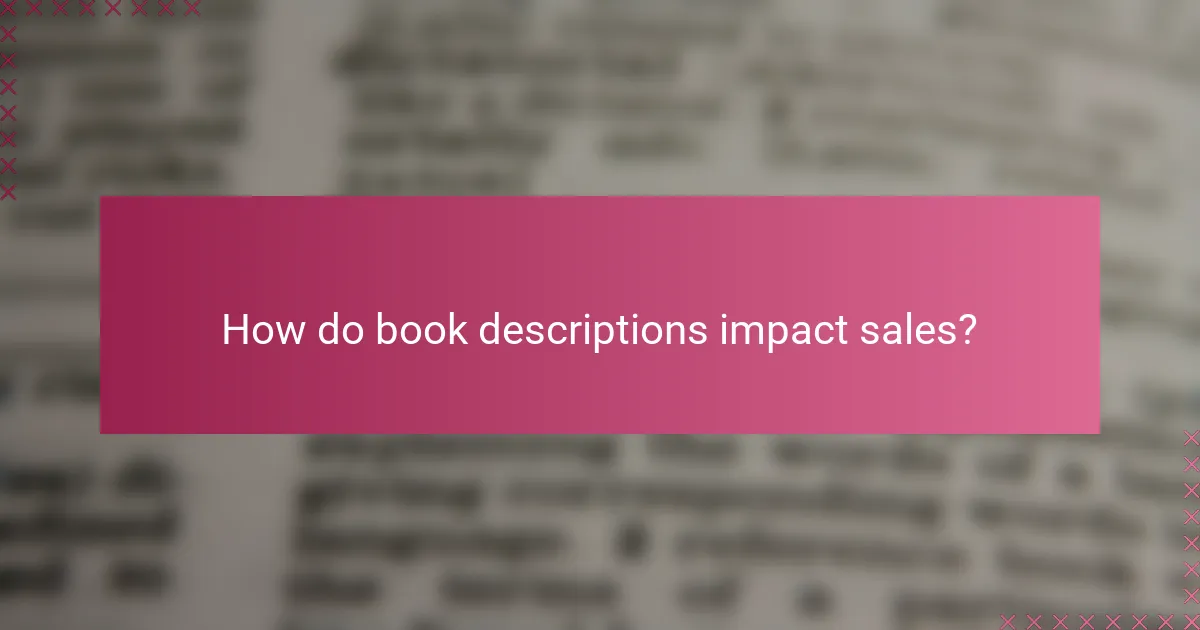
How do book descriptions impact sales?
Book descriptions significantly influence sales by enticing potential readers and providing essential information about the content. A well-crafted description can convert interest into purchases, making it a crucial element of marketing strategy.
Increased conversion rates
Effective book descriptions can lead to higher conversion rates by clearly communicating the book’s value to potential buyers. When readers understand what to expect, they are more likely to make a purchase decision.
Consider using persuasive language and highlighting unique selling points. For instance, mentioning awards, notable reviews, or compelling themes can capture attention and drive sales.
Enhanced reader engagement
Engaging book descriptions create an emotional connection with readers, encouraging them to explore further. Descriptions that evoke curiosity or resonate with readers’ experiences can lead to deeper interest in the book.
Utilize storytelling techniques in your descriptions. For example, starting with a provocative question or a brief anecdote can draw readers in and make them feel invested in the narrative.
Improved search visibility
Book descriptions also play a vital role in search visibility, impacting how easily potential readers can find your book online. Including relevant keywords can improve search engine rankings and attract more traffic to your book’s page.
Research popular keywords related to your genre and incorporate them naturally into your description. This practice not only aids in discoverability but also ensures that the description aligns with reader expectations.
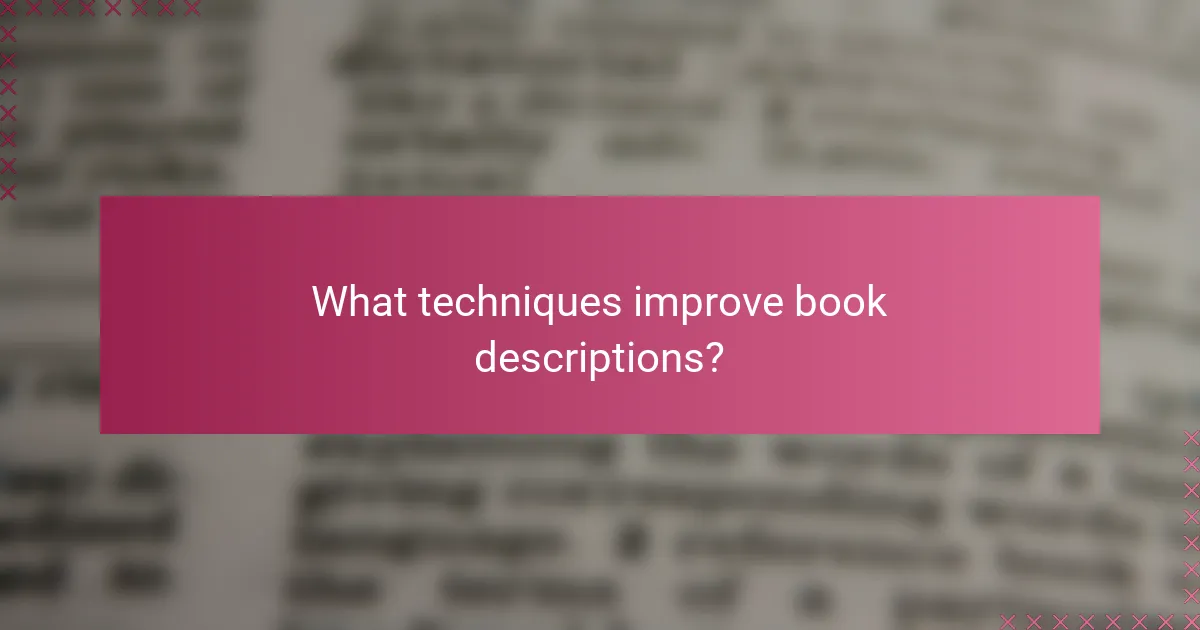
What techniques improve book descriptions?
Effective book descriptions engage readers and boost sales by using specific techniques that capture attention and convey the book’s essence. Key strategies include utilizing emotional triggers, incorporating relevant keywords, and highlighting unique selling points.
Utilizing emotional triggers
Emotional triggers are powerful tools that can connect with potential readers on a personal level. By tapping into feelings such as nostalgia, excitement, or curiosity, authors can create a compelling narrative that resonates with their audience.
For example, a romance novel might evoke longing and passion, while a thriller could instill suspense and urgency. Use evocative language and vivid imagery to paint a picture that stirs emotions, making readers eager to dive into the story.
Incorporating keywords effectively
Incorporating relevant keywords in book descriptions enhances visibility in search results and helps target the right audience. Identify popular terms related to your genre and themes, then weave them naturally into your description without compromising readability.
Aim for a keyword density of about 1-2%, ensuring that the text flows smoothly. Tools like keyword planners can help identify trending search terms, which can be integrated into the title, subtitle, and description for maximum impact.
Highlighting unique selling points
Unique selling points (USPs) differentiate your book from others in the market and attract potential readers. Clearly articulate what makes your book special, whether it’s an unusual plot twist, a unique setting, or a distinctive writing style.
Consider creating a bullet list of 3-5 key features that set your book apart. For instance, if your book includes expert insights or is based on true events, mention these aspects prominently to pique interest and encourage purchases.
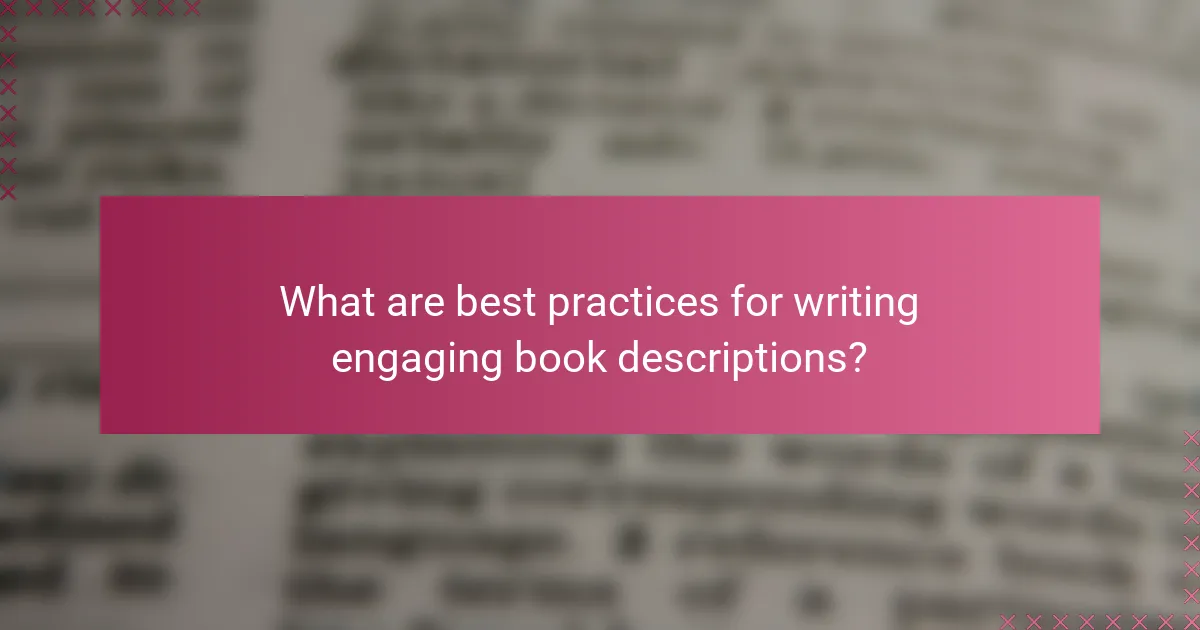
What are best practices for writing engaging book descriptions?
Engaging book descriptions are essential for attracting readers and boosting sales. They should capture the essence of the book while enticing potential buyers with compelling language and clear information.
Keeping it concise
A concise book description typically ranges from 150 to 300 words. This length is sufficient to provide key details without overwhelming the reader. Focus on the main plot points, themes, and characters to maintain clarity.
Avoid unnecessary jargon or overly complex sentences. Instead, aim for straightforward language that conveys your message quickly. Readers often skim descriptions, so make every word count.
Using active voice
Writing in active voice makes your book description more dynamic and engaging. For example, instead of saying “The story is told by the protagonist,” use “The protagonist shares her journey.” This approach creates a sense of immediacy and connection with the reader.
Active voice also helps clarify who is doing what, making the description easier to understand. This clarity can be the difference between a reader clicking “buy” or moving on to another book.
Creating a compelling hook
A compelling hook is a captivating opening line or question that grabs the reader’s attention. It should evoke curiosity and encourage them to read further. For instance, start with a provocative question or a bold statement related to your book’s theme.
Consider using vivid imagery or emotional language to create an immediate connection. A strong hook can set the tone for the entire description and entice readers to explore your book further.

How can authors optimize book descriptions for e-commerce platforms?
Authors can optimize book descriptions for e-commerce platforms by tailoring their content to meet specific platform guidelines, experimenting with various formats, and analyzing competitor descriptions. These strategies enhance visibility and engagement, ultimately driving sales.
Adapting to platform guidelines
Each e-commerce platform has unique guidelines regarding book descriptions, including character limits, formatting options, and keyword usage. Authors should familiarize themselves with these requirements to ensure their descriptions are compliant and effective.
For instance, Amazon often recommends keeping descriptions concise, ideally under 4,000 characters, while platforms like Kobo may allow for more extensive content. Using bullet points for key features can also improve readability and engagement.
Testing different formats
Experimenting with various formats can reveal what resonates best with potential readers. Authors should try different styles, such as narrative storytelling, straightforward summaries, or question-and-answer formats, to see which generates more interest.
Consider A/B testing descriptions by changing one element at a time, like the opening line or the use of bold text for key points. This method allows authors to gather data on reader engagement and refine their approach based on actual performance.
Analyzing competitor descriptions
Studying competitors’ book descriptions can provide valuable insights into effective strategies and common pitfalls. Authors should identify top-selling books in their genre and analyze how these descriptions are structured, the language used, and the types of keywords included.
Look for patterns in successful descriptions, such as emotional hooks or strong calls to action. This analysis can guide authors in crafting their own compelling descriptions that stand out in a crowded marketplace.
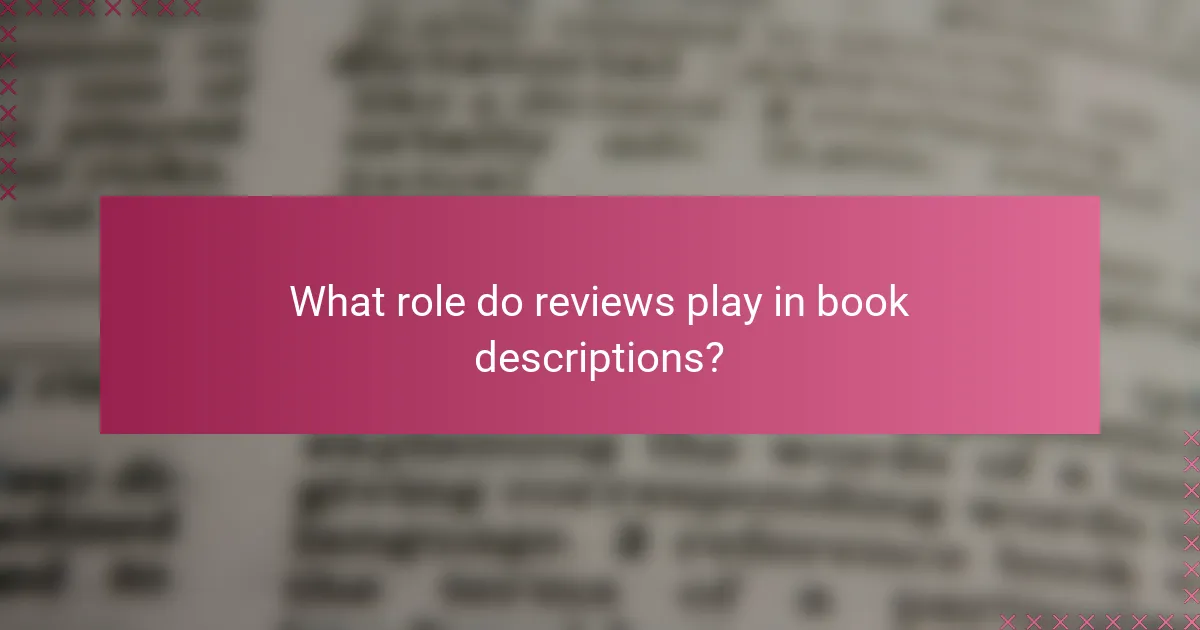
What role do reviews play in book descriptions?
Reviews play a crucial role in book descriptions by providing social proof and influencing potential readers’ perceptions. They can enhance credibility and significantly impact purchasing decisions, making them an essential component of effective book marketing.
Building credibility
Reviews help establish credibility by showcasing the experiences of previous readers. When potential buyers see positive feedback, it reassures them that the book is worth their time and money. A collection of reviews can create a sense of trust, especially if they highlight specific aspects of the book that resonate with the target audience.
To maximize credibility, aim for a diverse range of reviews. Include feedback from various readers, such as those who appreciate different genres or writing styles. This variety can appeal to a broader audience and reinforce the book’s strengths.
Influencing purchasing decisions
Reviews significantly influence purchasing decisions by shaping readers’ expectations and perceptions of a book. Positive reviews can lead to increased sales, while negative feedback may deter potential buyers. Many readers rely on reviews to gauge whether a book aligns with their interests and preferences.
To effectively leverage reviews, consider highlighting key excerpts in your book description. Use phrases from reviews that emphasize the book’s unique selling points or emotional impact. Additionally, encourage readers to leave their own reviews after reading, as fresh feedback can keep the momentum going and attract new buyers.
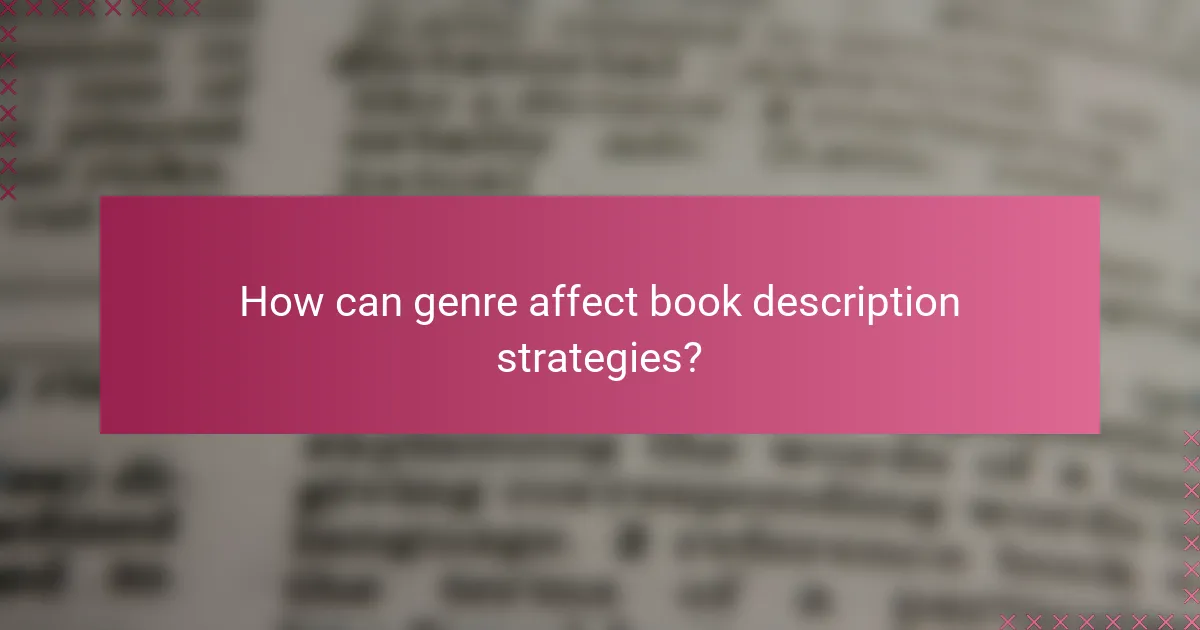
How can genre affect book description strategies?
Genre significantly influences book description strategies by dictating the language, tone, and elements that resonate with target readers. Understanding genre conventions allows authors and marketers to craft compelling descriptions that attract the right audience and enhance sales potential.
Tailoring language to genre conventions
Each genre has its own set of conventions that dictate the appropriate language and style. For instance, a romance novel may benefit from emotive and descriptive language that evokes feelings, while a thriller might require concise, suspenseful wording that builds tension. Identifying these conventions is crucial for engaging the intended readership.
When writing a book description, consider the expectations of your genre’s audience. Use terminology and phrases that are familiar to them. For example, fantasy readers often look for world-building elements, while science fiction fans appreciate technological details. Tailoring your language accordingly can significantly improve reader engagement.
Highlighting genre-specific elements
Incorporating genre-specific elements in your book description is essential for capturing the essence of your story. For example, in a mystery novel, emphasize the protagonist’s investigative skills and the central puzzle, while in a historical fiction piece, highlight the time period and key historical events that shape the narrative.
Consider creating a checklist of elements to include based on your genre. For romance, list emotional stakes and character dynamics; for horror, focus on atmosphere and fear factors. This targeted approach ensures that your description resonates with genre enthusiasts and sets clear expectations for what they can anticipate in the book.
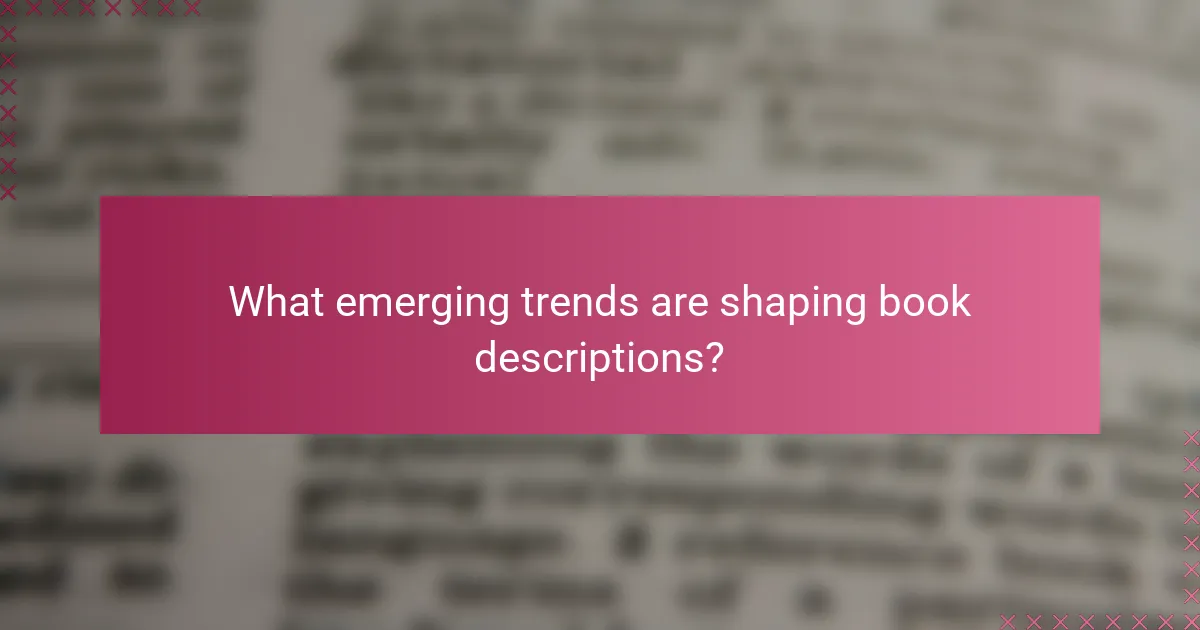
What emerging trends are shaping book descriptions?
Emerging trends in book descriptions focus on personalization, brevity, and the use of technology to enhance engagement. Authors and publishers are increasingly leveraging these trends to capture reader interest and boost sales.
Personalization through AI
Personalization through AI is transforming how book descriptions are crafted, allowing for tailored content that resonates with individual readers. By analyzing reader preferences and behaviors, AI can generate descriptions that highlight elements most likely to attract specific audiences.
For example, an AI tool might emphasize romance themes for readers who frequently select love stories, while focusing on action for fans of thrillers. This targeted approach can significantly increase engagement and conversion rates.
When implementing AI for personalization, ensure that the descriptions remain authentic and reflective of the book’s content. Avoid over-reliance on algorithms; human oversight is crucial to maintain quality and relevance.
